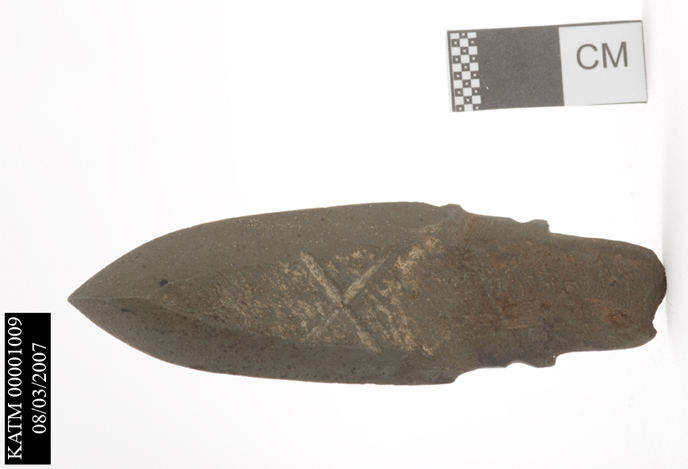
Katmai’s Object of the Month for March is a slate point, a wooden shaft and a wooden carrying case. These objects were part of a cache of points, cases and shafts found in a crevice along Grosvenor Lake 50 years ago. In 1964, George Gryc, then chief of the Alaska Geology Branch of the USGS, visited the geological survey party that was mapping the Iliamna quadrangle, which was then just north of Katmai National Monument. During his visit, the geologists landed on Grosvenor Lake to do some mapping. During their lunch break, Gryc began investigating a sandstone bluff near the edge of the lake, looking for fossils. According to a 1972 letter to the superintendent from Gryc:
“I noticed, rather incidentally, a stick that seemed unusually weathered lying on a ledge. I picked it up and noticed that it was worked. I looked around and after some searching noticed a couple of more similar pieces (shafts) sticking out of a crevice that slanted diagonally back into the bluff. I pulled out the shafts and heard a clink as though I had disturbed something well back in the crevice. Unable to reach in or see into the crevice I fashioned a hooked stick and began to fish in the crevice. I pulled out the nine points and three cases that I have sent to you.”
This was an exciting find—archeologists usually find stone objects like slate points, but rarely do they find wooden objects like the shafts the points were lashed to and the carrying cases that protected the well-sharpened edges of the points. Gryc submitted a section of one of the wood shafts for carbon 14 dating; the results came back that the wood was no older than 200 years old. However, radiocarbon dates of anything under 250 years old are notoriously unreliable due to the somewhat recent industrial uses of coal and oil as fuel that have filled the upper atmosphere with particles of ancient carbon and the radioactive materials that have entered the atmosphere due to atomic testing.
Is this date correct? How can we find out how old these objects are? Research! Gryc consulted with archeologists William Laughlin and Don Dumond, as well as researchers at the Smithsonian. Dr. Laughlin remarked how exquisitely worked the spear points were and how well preserved the shafts and cases were. Dumond, the pioneering archeologist in the Katmai region, concluded these spear points are characteristic of the Naknek area from about 1700-1800AD.

This wooden sheath (above) and the spear point are similar to others found in the Katmai area. Two halves of the wooden sheath or carrying case would have been lashed together around the point with sinew, skin, or vegetal material in order to protect the carefully honed edges of the slate point between hunts. The point would have also been lashed to the shaft using the same material. This half of the sheath broke at some point in the past—instead of making a new half, the hunter or someone he knew fixed the case using a wooden peg, which is clearly visible
We know similar artifacts from Kodiak and Katmai Village at the Hermitage Museum and the National Museum of Finland collected ethnographically date from the early-mid 1800s. A note in the museum catalog at the National Museum of Finland sated that wooden sheaths similar to the ones found at Grosvenor were no longer in use by 1850. This would make sense, as hunters would have, by that time, replaced slate points with metal ones, and soon would replace spear points all together with guns.

This slate point was shaped by very careful and fine grinding rather than by chipping. In this photo an incised “X” in the middle of the point indicates an owner’s, or maker’s mark.
Who was the hunter who used these points? What was he hunting? Did he use these points each time he hunted in this particular area, caching them between hunts? Did he store them away in a crevice above the lakeshore for ceremonial reasons? We don’t know the answers to these questions, but we know that these finely crafted tools were very important to someone in the past, and are a wonder to us in the present!

Archeologists were fortunate to determine so much information from these objects since they were removed from their original context. Please remember that all natural and cultural resources are protected in Katmai. It is especially important to not disturb archeological resources. Please notify park staff if you find any artifacts.
